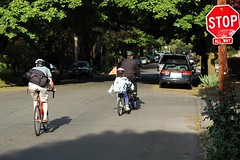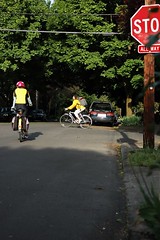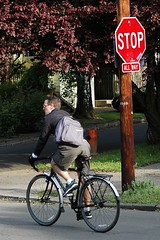Exactly one year ago today, the Portland Police Bureau Traffic Division carried out a stop sign enforcement action (a.k.a sting) at SE 23rd and Salmon.
Many cyclists received tickets and the incident touched off a heated debate (that rages on today). This debate includes issues like; the use of police resources, the conduct of law-breaking cyclists, questions about the effectiveness (and necessity) of stop signs, and so on.
I highly recommend a quick look back at my initial post and the comments from one year ago, as well as the follow-up statement by Lieutenant Mark Kruger. Those stories and perspectives offer an important education on the issues raised by the policies, behavior and practices of PDOT, the Police Bureau, and cyclists.
Since these enforcement actions (and resulting disagreements over them) are still being carried out, and because I was curious if anyhing has changed in the last year, I went back to that intersection this morning and did a little informal survey.
Here’s what I found out…
Conditions: Sunny, cool morning
The Numbers
Bikes (53 total)
Full stop – 9
Partial stop – 36
No stop – 8 (including one young kid)
Cars (16 total)
Full stop – 14
Partial – 2
No stop – 0
The Analysis
Several things surprised me during my short (and highly unscientific) observation.
First, I was amazed at how many more bicycles use this street than cars. It makes me wonder at what point does (or should) PDOT policy (engineering and enforcement) change to reflect the reality that streets like this one see more bikes than cars? It gives new meaning to the term bicycle boulevard.
Secondly, a very small percentage of cyclists follow the letter of the law at this intersection. Out of 53 total bikers, only nine came to a complete stop, and three of those were due to the presence of a motor vehicle.
I also spoke to a few folks.
The first guy I talked to actually got a ticket at this spot last year. He rides the route everday and says he would have come to “almost a complete stop” if I hadn’t waved him over prior to the sign.
I asked what he thought about the stop sign,
“I think that just generally, that since bikes cause almost no potential risk to other people, that vehicle laws should be changed to take into consideration the fact that bikes don’t have the same risk to other people that cars do… I slow down, I look both ways, but if I’m wrong, I’m the one who’s gonna’ get hurt, not the person in the car.”
Should they take out the sign?
“I defer to the people that live right around here. If there’s lots of little kids in this area…than they probably have a good reason to have a stop sign.”
That was an interesting response, because the cops initially started this enforcement based on a complaint from a nearby resident.
Another guy I talked to had a confession to make,
“I used to blow through the sign all the time, but when the cops started giving tickets out I stopped doing that because I didn’t want to get a ticket.”
I noticed one cyclist crossing the intersection (heading north). She said she’s nearly been hit by cyclists in this intersection.
According to BTA Director Evan Manvel, this stop sign was put in when PDOT made this an official bikeway back in the ’80s. He said the person who lived on one of the corners spoke up and made it happen.
As I rolled back toward town (riding downhill, westbound on Salmon) I couldn’t help but notice that similar intersections at SE 13th, 14th, and 17th do not have stop signs and seem to work just fine.
Given my observations, while it’s clear some cyclists remember last year’s enforcement action, it seems like it was more of a band-aid solution to a larger problem. That problem is two-fold; engineering and education.
We need to have PDOT take a closer look at this (and Ladd Circle) and engage the community to decide what works best for all the stakeholders (PDOT, Police, cyclists, neighbors). It would also help the entire equation if more cyclists tried just a little bit harder to follow the rules of the road.





